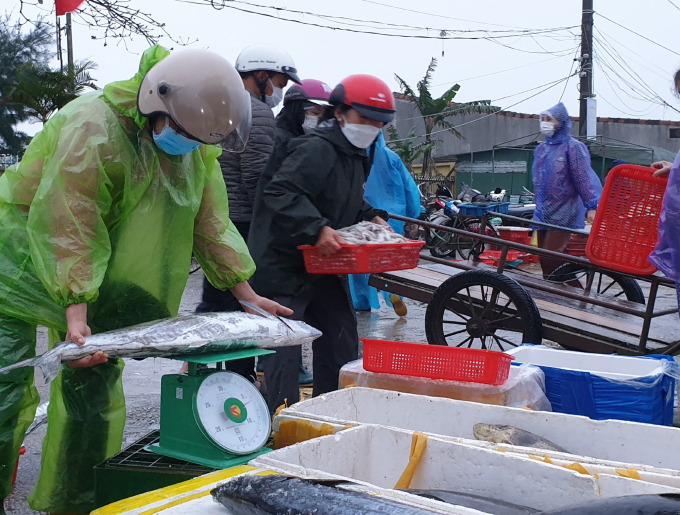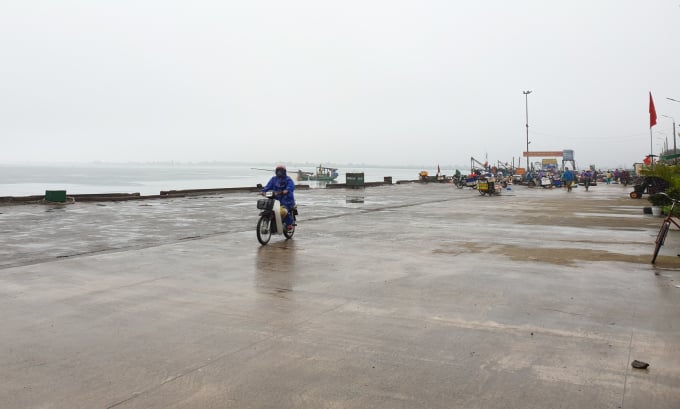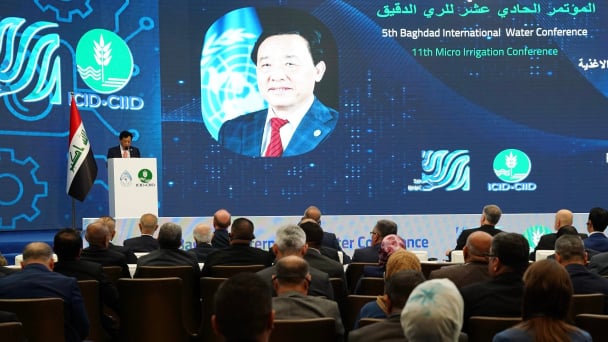June 2, 2025 | 20:28 GMT +7
June 2, 2025 | 20:28 GMT +7
Hotline: 0913.378.918
June 2, 2025 | 20:28 GMT +7
Hotline: 0913.378.918

Without a wharf, Ha Tinh fishermen have to manually transfer fish. Photo: Thanh Nga.
In March, the sea was rough, hundreds of boats are struggling to get to the anchorage of Cua Sot port, Thach Kim commune, Loc Ha district (Ha Tinh province) to avoid a tropical depression.
Crew member Nguyen Van Phan, residing in Hoang Mai town, Nghe An, who has 20 years of experience in driving vessels, shared that in recent years, he had difficulties arriving and leaving Cua Sot port.
The port is small while the number of ships is large. In the rainy season, the ships are usually hit by big waves, leading to shipwrecks and huge property damage.
For seafood trading activities, because there is no wharf, fishermen here have to hire people to carry fish and shrimp ashore manually, which increases costs and reduces profits.
Trader Nguyen Thi Huyen, Thach Kim commune, Loc Ha district, has been buying fish and squid at Cua Sot port for nearly two decades. She said that when a ship docks at the port, she had to hire three or four workers to transfer fish and squid from the ship to shore to freeze before selling the seafood to wholesalers at markets. The transport is potentially dangerous for workers and unsafe for food.
“Many days when the sea was rough and it rained, workers transported fish and fell into the sea. Fortunately, they were rescued in time. Fish and squid mixed with rainwater, falling to the ground, sticking with dirty sand," Huyen said.
Phan said that Cua Sot fishing port was not only small in size but also lacks a lot of basic and necessary infrastructure such as warehouse system, goods storage yard, cargo handling equipment, electricity, water supply and drainage systems, wastewater treatment system, lights and logistics area.

Lack of infrastructure for post-harvest preservation and processing, the economic value of Ha Tinh’s seafood is significantly limited. Photo: Thanh Nga.
About 1,000 vessels and over 3,900 workers usually visit Cua Nhuong fish mound, Cam Xuyen district but trading activities are taken place on an unsecured sand mound that failed to meet food safety and hygiene requirements.
“Cua Nhuong Mound is small, constantly being deposited, so only small vessels can enter. Moreover, because there is no port system, the expansion of fisheries in the locality is very limited, unable to modernise," said Le Van Danh, Head of the Agriculture and Rural Development Department of Cam Xuyen district.
At the same time, Danh said that the synchronisation of infrastructure was an inevitable and urgent trend to meet the needs of fisheries development, especially in the context that the country's fisheries industry is trying to implement solutions to remove IUU "yellow card".
Le Duc Nhan, Deputy Director of the Department of Agriculture and Rural Development, said that for the last few years, the province's leaders have paid intension to aquatic resources exploitation and protection as well as investment in infrastructure systems at fishing ports.
Ha Tinh province has assigned the Agriculture and Rural Development Construction Investment Project Management Board to implement two new construction projects of Cua Nhuong fishing port, Cam Xuyen district and the expansion of Cua Sot fishing port, Loc Ha district, with a total investment of VND340 billion.
In addition, this board is also preparing an investment project to build fishery logistics service infrastructure at Cua Khau - Ky Ha storm shelter anchorage area, Ky Anh town, and dredging and repairing channels and entrances of Cua Hoi - Xuan Pho shelter in Nghi Xuan district.
Ha Van Tra, Director of Ha Tinh Agriculture and Rural Development Construction Investment Project Management Board, said that it was urgently completing the construction designs, selecting contractors so that the construction of expanded Cua Sot fishing port and Cua Nhuong fishing port would start in the middle of the second quarter and expectedly complete by the end of 2022.
“The two projects are very important to fishermen. Hopefully, after the project is completed, it will contribute to changing the production mindset of fishermen to industrial production," said Tra.
According to the province’s approval decision, Cua Sot fishing port is built to meet the criteria of a grade II fishing port. The project will expand the wharf to meet the demand for fishing vessels from 90 CV to 400 CV; build protection embankments from type 1 to type 3; dredge the creek; build a system of roads with a total length of more than 487 m.

Ha Tinh province has just invested VND60 billion to expand Cua Sot fishing port, Loc Ha district. Photo: Thanh Nga.
The construction also includes a rainwater drainage system, a wastewater treatment system, sanitary works; fence, a power supply, and a water supply.
For the Cua Nhuong fishing port project, the construction scale is to meet the ship's capacity of 400 CV, dealing with 100 arrivals per day with the volume of aquatic products reaching the port is about 16,000 tons/year.
The main investment items include a dock for vessels with capacity from 150 CV to 400 CV; berths for vessels under 150 CV; aqua-receiving yard with an area of 2,400 sq.m, dredging the channel to the port and the water area in front of the port, an inland waterway signaling system and shore protection embankment.
The fishing port will also have a 780m-long sand-blocking dike, 3 internal roads in the port, an operator house, a fishery gathering house, a solid waste collection house, a shoreline dock, electricity supply items with a total project investment of up to VND280 billion.
Ha Tinh province currently has nearly 3,600 boats registered to operate. Of which, ships with a length of 15m or more are 115; ships from 12m to 15m have 636 ships; the rest are ships with a length of less than 12m.
The fishing port will facilitate the trade and trading activities of Ha Tinh fleet and attract vessels from neighboring provinces of Nghe An, Thanh Hoa, Quang Binh, even Quang Ngai, Quang Nam to dock, increase economic efficiency and the local State budget.
Translated by Hien Anh

(VAN) TTC AgriS and IFC signed a strategic partnership to develop a sustainable agricultural value chain, aiming to achieve the Net Zero target by 2035.

(VAN) Seafood by-products are opening a new path, combining green growth and technological innovation to enhance the industry's value.

(VAN) Mr. Nguyen Thanh Cong, Vice Chairman of the Son La Provincial People's Committee, reflects on Son La’s journey from barren hills to fruitful orchards after a decade of hard work.

(VAN) FAO’s Director-General addresses the 5th Baghdad International Water Conference.
/2025/05/26/1716-4-nongnghiep-191706.jpg)
(VAN) Chain linkages, technological innovation, and raw material zoning are three strategic pillars for the coconut industry to strongly develop and elevate its position on the global agricultural map.
![Advanced mariculture – an inevitable trend: [4] Accompanied by scientists](https://t.ex-cdn.com/nongnghiepmoitruong.vn/608w/files/sohk/2025/05/13/1941-pgsts-vo-van-nha-140958_717.jpg)
(VAN) According to Assoc. Prof. Dr. Vo Van Nha, Director of the RIA III, the development of advanced offshore mariculture is no longer an option but an essential path for Vietnam’s fisheries sector.

(VAN) Vietnam is intensifying the development of mollusk farming areas that meet international standards, aiming for sustainable growth and enhancing its export position in the global seafood market.